Over the past year, the number of new Layer 2 (L2) solutions has increased significantly due to technological advancements, focus on specific application scenarios, and strong community participation.
While this development is encouraging, the main challenge remains how to scale these blockchains in a more cost-effective manner. Executing application chains has become a key means to solve this problem, because application chains can control the operating costs of the blockchain through various initiatives in the modular infrastructure stack.
While L1-Ethereum specific initiatives have significantly reduced transaction costs on the blockchain, major rollups and infrastructure service providers are also pushing hard to further improve the extensibility and unlock use cases that are currently too costly to execute on the chain. .
We can classify and analyze these developments through the following three categories:
1. L1 approach 2. L2 approach 3. Modular infrastructure approach
All of these make a meaningful contribution in reducing the barriers to entry for on-chain transactions.
The first is that Ethereum has received some upgrades, such as EIP 1559 and 4844, which have reduced costs and improved scalability.
Let’s look at the contribution of L1 initiatives to rationalizing transaction costs on the Ethereum chain, such as EIP 1559 and EIP 4844 (Cancun Upgrade). EIP 1559 introduces the concept of base fee + tip/priority fee, as well as a dynamic pricing mechanism based on network congestion, providing users with a better mechanism to estimate costs based on their priorities and network congestion. Trade online.
EIP 4844 introduces a new transaction type to Ethereum through the concept of Blob, allowing L2 to store data in the form of Blob instead of expensive callData, thus significantly reducing costs when L1 settles transactions.
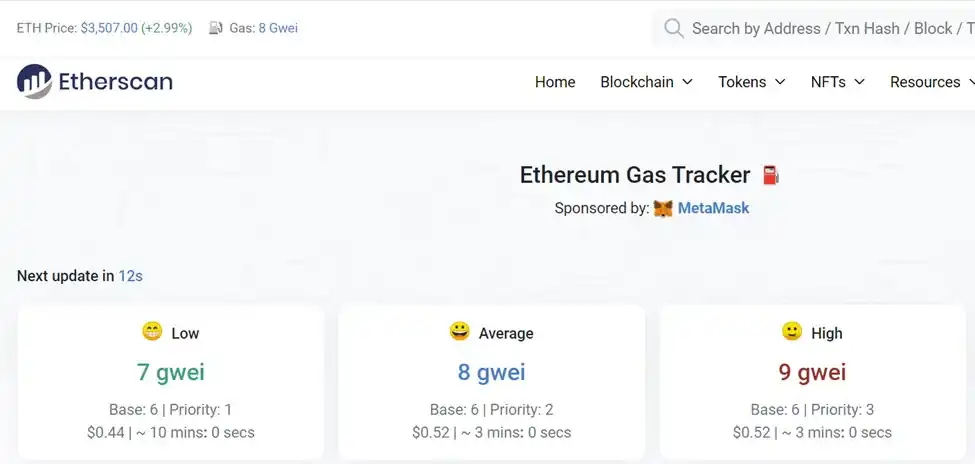
The implementation of Blobs has resulted in significant reductions in transaction costs due to lower storage costs per tuple and scaling of per-block capacity, as Blobs do not compete for Gas with Ethereum transactions and are not stored permanently, expiring in approximately 18 days Removed from the blockchain.
Each blob contains 4096 32-byte field elements, and the total number of blobs in a block is capped at 16, providing an additional maximum capacity of approximately 2 MB (4096 * 32 bytes * 16 blobs per block) . The current starting capacity is 0.8 MB, with a target of 3 blobs per block and a maximum of 6 (after EIP 4844 is implemented). Considering the historical callData standard of 2-10KB per block, EIP 4844 means a theoretical capacity increase of up to 384x.
In fact, after the implementation of EIP 4844, the cost of many L2s dropped by more than 90%. However, relying on these upgrades alone is not enough to enable greater scalability for Ethereum. In the case of thousands of Rollups, transaction costs may rise sharply as storage space requirements increase with the emergence of large-scale applications on the chain.
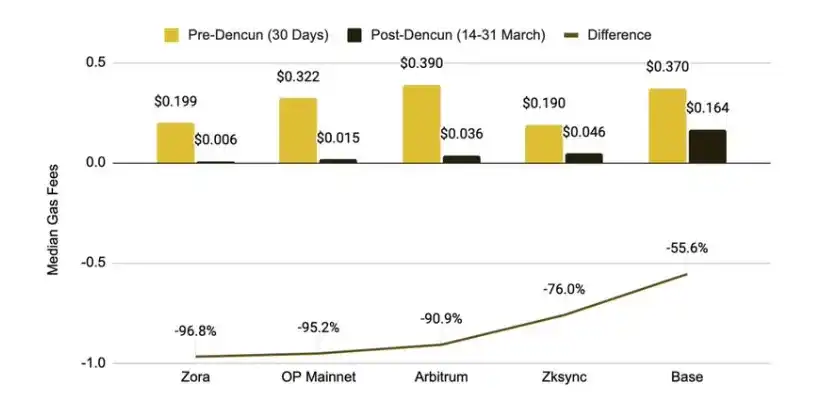
As L2 moves execution off-chain to cut costs and maintain security, industry initiatives such as open source frameworks and revenue sharing models are shaping the competitive landscape of the “L2 War.”
The emergence of Rollup in the last cycle aims to significantly reduce on-chain operation costs by moving execution out of the main chain while obtaining security from the main chain. While Op Rollup allows a single honest entity to submit a "fraud proof" and receive rewards for identifying misbehaving sequencers, ZK Rollup uses zero-knowledge proofs to prove that the L2 chain has been updated correctly.
Rollup performs the following tasks:
- Sorting: Organize end-user transactions sequentially, group them, and occasionally release batches of these groups to L1
- Execution: Store and execute operations and update the status of the Rollup
- Proposed: Proposer regularly updates the Rollup state root on L1, which is important to ensure that the blockchain remains trust-agnostic and verifiable
- State Root Challenge: Submit evidence of State Root fraud and challenge the State Root on L1 (Op Rollup only)
- Proof: Verification of generated state root state updates from Rollup to L1 (only for ZK Rollup)
They profit from user-paid transaction fees (sorter revenue) and the potential MEV (maximum value that can be extracted), although MEV has not yet been extracted as part of the strategy. Their costs mainly come from L2 (operational costs) and L1 (data availability and settlement) costs.
Organizations looking to launch their own chain will typically only consider doing so if they expect transaction fees to be higher than the cost of such a move.
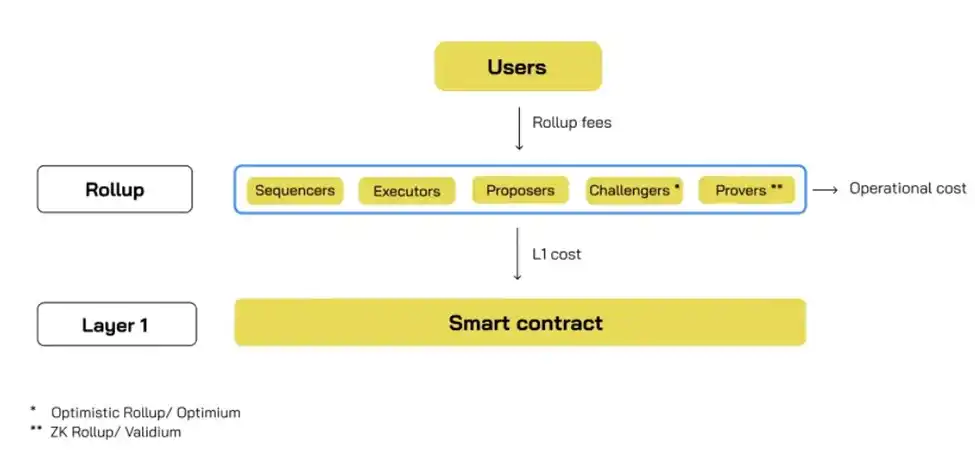
Base layer networks like Ethereum typically charge more for computation and storage due to the need for a majority of nodes to sync and verify the chain. However, in Rollup, a chain is considered safe even if only one honest entity is able to verify the chain. Therefore, Rollup charges lower fees for computing and storage, but charges higher fees for rolling up transactions, packaging and publishing to L1. As a result, L1 costs accounted for 98% of the L2 cost base before the launch of EIP 4844.
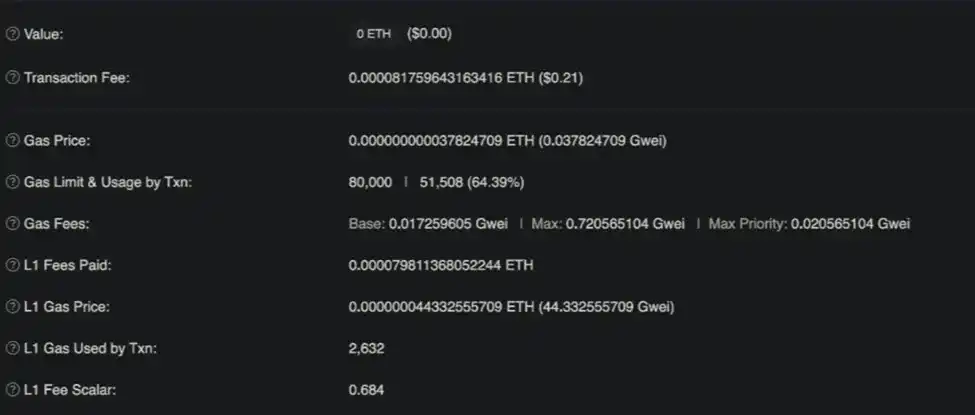
In addition to base layer optimization, L2 also vigorously promotes further cost reduction. These initiatives are called L2 practices at the beginning of the article and can be mainly divided into two categories: industry alignment or company alignment.
Industry alignment initiatives include allowing new players to build their own chains through an open-source L2 technology stack (Rollup framework). This wave of initiatives was initially led by Op Rollup with the launch of OP Stack and Arbitrum Orbit, with other mature L2 players such as Polygon (Polygon CDK), ZK Sync (ZK Stack) and Starkware (Madara Stack) following suit by open sourcing their Proprietary technology drives large-scale application.
Corporate alignment initiatives are where these chains reduce costs and accumulate value for their tokens, either through direct revenue/profit sharing models or indirectly through secondary effects of expanding their ecosystems. Optimism's Superchain vision, Arbitrum's expansion suite plan, Polygon's aggregation layer, ZK Sync's Elastic Chain are all examples of such initiatives.
The specifics of these projects may vary, but what they have in common is that they all have an Internet network that provides enhanced interoperability, communication between multiple Rollups, and shared critical infrastructure, such as a shared data availability layer, Shared cross-chain bridges, aggregation proofs (only applicable to ZK chain), etc. to further improve capital efficiency - this is a problem faced by the current lack of interoperability between liquidity dispersion and Rollup in the Ethereum ecosystem.
However, these stacks also allow each chain to be uniquely customized based on its needs in terms of block times, withdrawal periods, finality, token usage, gas limits, etc., thus eliminating the high cost associated with executing on a public chain. Gas costs and latency issues caused by other applications.
While these independent ecosystems are focused on growth and adoption, we are already starting to see some established players such as Optimism and Arbitrum move towards monetization.
Optimism charges 2.5% of total sequencer revenue or 15% of sequencer profit (sequencer revenue – L1 settlement and data availability costs) on participants wishing to become part of its Superchain.
Arbitrum charges 10% of the sequencer's profit for participants who use its stack to release L2. ZK Rollup stacks including Polygon CDK and ZK Stack are currently free to use, but as they develop and are used, they may have built-in Sustainable economic model.
As all ecosystems compete to attract important projects through unique strategies, the "L2 stack war" has officially begun. Optimism announced a $22 million bounty for Superchain builders, offering retrospective airdrops based on usage and participation metrics, while ZK Sync offered $22 million in ZK tokens to entice Lens to migrate from Polygon to its stack.
Arbitrum provides its stack for free, provided that participants release it on Arbitrum as L3 (referring to using L2 as the settlement layer instead of Ethereum). Because Arbitrum increases benefits through L3 activities, these L3 chains will always provide support to Arbitrum during their life cycle. Arbitrum pays settlement costs.
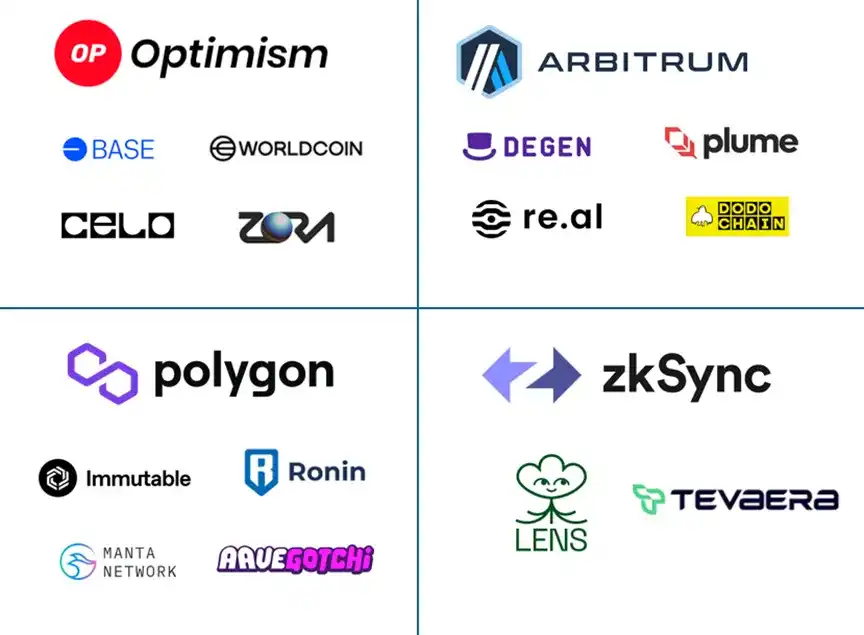
RaaS and alternative settlement and data availability solutions have redefined the blockchain cost structure, and future modular infrastructure innovations are expected to further reduce costs.
Despite the availability of these technology stacks, implementing blockchain involves significant operational overhead, personnel, expertise, and resources. Developers looking to attract on-chain users do not want to be distracted from the execution and maintenance of the chain infrastructure, but rather want to focus on core business activities.
This problem has prompted the emergence of RaaS service providers, who work with these developers to abstract the complexity of the execution chain using mature L2 frameworks/stacks. The services they provide include node operations, software updates, infrastructure management, and the provision of sequencing, indexing, analysis and other products.
RaaS service providers have adopted different market capture strategies, some aligned with specific L2 ecosystems, others taking a more framework-agnostic approach, providing integration across all ecosystems.
Conduit and Nexus Network integrate with Op Rollups such as Optimism and Arbitrum, while Truezk, Karnot and Slush focus on ZK chains. On the other hand, Caldera, Zeeve, Alt Layer and Gelato provide integration across Op and ZK Rollup.
The typical business model for these providers consists of a fixed fee plus a share of the sequencer's profits. The monthly subscription fee to perform an Op Rollup typically ranges from $3,000 to $4,000, while the cost to perform a ZK Rollup can be more than twice that, reaching $9,500 to $14,000, due to the extreme computational intensity required to generate ZK proofs and the complexity of proof verification. The cost is extremely high.
In addition, to align the incentives of RaaS providers and Rollup, a 3-5% share of sequencer profits is typically levied as a share, allowing them to capture the economic upside as the appeal of these chains increases.
Caldera is exploring a different model with its Metalayer vision, which charges only 2% of the orderer profit share, has no fixed costs, and aims to enable interoperability between chains using Caldera, whether Op or ZK series.
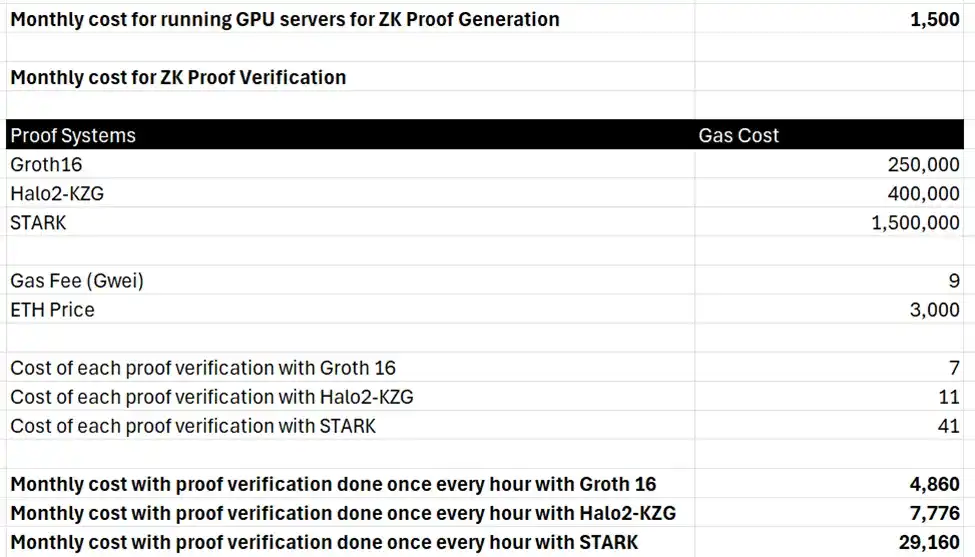
It should be noted that the changes in the industry and the team's efforts on these stacks, especially the ZK stack, may further compress the subscription costs of RaaS service providers. Additionally, as strong consumer-grade Web3 businesses are scarce, large consumer-facing applications may be able to negotiate better economic sharing agreements with infrastructure providers, so initial pricing may not be standardized.
As mentioned before, the largest expenditure of Rollup is L1 cost, which is data availability and settlement cost. For a standard rollup processing 100 million transactions, L1 costs can be as high as $25,000 per month, making L1 settlement feasible only for the largest and most commonly used chains. The need for alternative settlement and data availability solutions has driven dedicated players to optimize cost and performance at these tiers.
Ethereum's data availability alternatives include Celestia, Near, EigenDA, and the mature L2 discussed above is intended to be Rollup's settlement layer, which can classify these chains as L3. These players have reduced Rollup's settlement and data availability costs by orders of magnitude compared to Ethereum.
The figure below provides a rough cost comparison, showing how much cost savings would be achieved if Rollup released callData to Celestia instead of Ethereum. It is worth emphasizing that as transaction volume increases, the gap in cost savings increases exponentially.
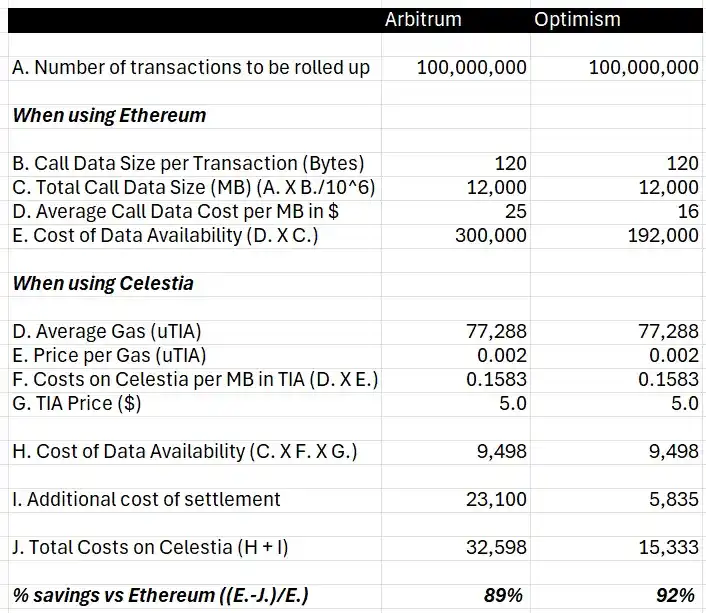
In addition to the data availability cost, there is also a settlement cost, that is, Celestia releases a mark on Ethereum, pointing to the relevant block on Celestia, to ensure the ordering and integrity of the data released on Celestia.
The development of specialized players across the modular infrastructure stack, such as alternative data availability and RaaS service providers, can be collectively referred to as the modular infrastructure movement. There are other categories of innovation that are further optimizing costs, including shared sequencers (Espresso, Astria, Radius), proof aggregation (Nebra, Electron), and others. These are currently in the early stages of development and we expect costs to fall further as the industry matures.
Even though the cost of operating on-chain has decreased significantly, Web2 founders should still conduct a thorough cost-benefit analysis before deciding to launch their own chain.
The full cost of executing a chain depends on the specific usage requirements of each chain, but we can roughly estimate the cost of using alternative data availability solutions for an average Op or ZK chain processing 2 million transactions per month, as shown in the figure below.

Despite various optimizations at the industry level and individual chain level, it still requires a total monthly fee of $10,500 to $16,500 for ZK Rollup and $4,000 to $6,500 for Op Rollup, in addition to sequencer profits once the chain starts to make profits. Up to 20% needs to be shared.
The three categories of initiatives highlighted in this article will be key to popularizing the industry, with the ultimate goal of closing the cost and convenience gap between decentralized applications and Web2. Builders should carefully evaluate the cost-benefit analysis of executing a standalone chain versus building on an existing chain based on their end-user needs, product priorities, performance metrics required for use cases, and existing market appeal.
We found that building solutions to reduce the cost and performance differences between Web3 and Web2 infrastructure is necessary because society's preference for using decentralized systems is not sufficient to expand the scope of Web3 applications. This challenge remains to promote blockchain A key bottleneck for large-scale applications.








